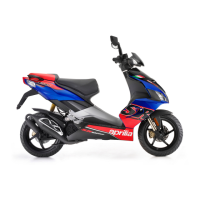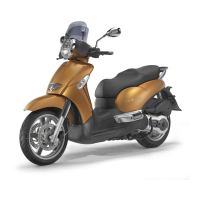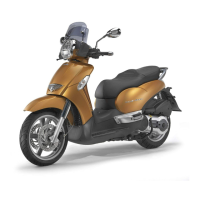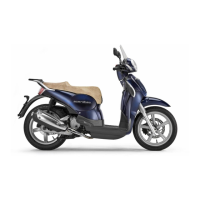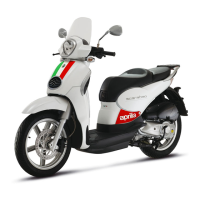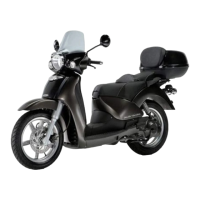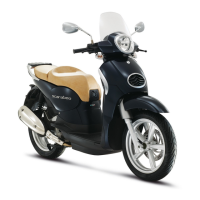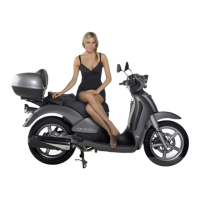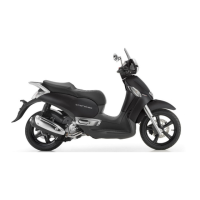
Do you have a question about the APRILIA SCARABEO 50 2T - 2005 and is the answer not in the manual?
| Engine Type | Single-cylinder, 2-stroke |
|---|---|
| Fuel System | Carburetor |
| Cooling System | Air-cooled |
| Transmission | Automatic CVT |
| Front Suspension | Telescopic fork |
| Rear Suspension | Single shock absorber |
| Dry Weight | 90 kg |
| Front Brake | Disc brake |
| Rear Brake | Drum |
Explanation of the safety warning symbol used in the manual.
Defines WARNING for severe risk, CAUTION for minor risk.
Driving requires license, age limit, fitness, insurance, registration.
Alcohol, drugs, and illness affect riding safety.
Maintain hands on handlebars, feet on footboard, correct posture.
Check controls, pipes, wires, brakes after an accident.
Have vehicle inspected by dealer after maintenance.
Do not ride if damage makes the vehicle unsafe.
Wear and fasten helmet correctly; ensure it's compliant and clean.
Wear bright/reflective clothing for visibility and protection.
Be careful not to overload the vehicle with luggage.
Place luggage near center of gravity, distribute weight evenly.
Secure luggage firmly; avoid bags protruding too much or covering lights.
Overloading makes the vehicle unstable and poorly handled.
Diagram and labels for 50 2T handlebar and dashboard controls.
Diagram and labels for 50 4T/100 4T handlebar and dashboard controls.
Blinks when direction indicators are active.
Illuminates when mixer oil level is low.
Details Dimmer, Indicator, and Horn controls on the left handlebar.
Details the Starter button on the right handlebar.
Warnings about flammability, explosion risk, and safe refueling practices.
Low oil level damages engine; consumption varies with use.
Check oil level every time the vehicle is used.
Steps to check engine oil level with a cold engine.
Top up oil if below minimum; never exceed MAX level.
Change intervals for 50 2T and 50/100 4T models.
Sudden lever changes indicate hydraulic issues.
Brakes are critical; check before each ride.
Clean dirty discs, replace worn pads.
Steps to check front brake fluid level.
How to adjust the rear brake lever idle stroke.
Check tyre pressure, condition, and wear; avoid over/under inflation.
Replace worn/punctured tyres; balance wheels after repair.
Have tyre operations done by qualified technicians or dealers.
Table listing parts, checks, and reference pages for pre-ride inspection.
Steps for starting the engine using the electric starter.
Steps for starting the engine using the kick starter.
Procedure to clear a flooded engine.
Steps if the engine does not start.
Read 'Safe Riding' section before moving off.
Gentle braking and avoidance of prolonged braking.
Release throttle and gradually apply brakes.
Lock the steering using the ignition switch key.
Fire safety, hot parts, and non-edible parts warnings.
Contact dealer for assistance; perform pre-ride checks after service.
Inspect/clean filter monthly or every 3000 km; more if dusty/wet.
Do not use petrol/flammable solvents; use clean, non-flammable ones.
Protect brake hoses, discs, and pads during disassembly.
Do not pull brake lever after wheel removal to prevent fluid loss.
Protect brake pipe, disc, and pads during reassembly.
Pull brake lever repeatedly and check system operation.
Difficult for unskilled operators; contact dealer if needed.
Work rear brake lever and check operation after refitting.
Inspect pad wear visually between disc and pads.
Metal-to-metal contact with disc leads to loss of braking and damage.
Check rear brake shoe wear after 1000 km and then every 4000 km.
Verify tightening of parts and operation of joints.
Steps to check for clearances in the steering system.
Contact dealer if clearance is detected in steering.
Adjust idling after first 500 km and when erratic.
Steps to adjust idling speed using inspection cover and rev counter.
Ideal slack for throttle control should be 2-3 mm.
Steps to adjust slack using adjuster nut and knob.
Ensure handlebar movement doesn't affect idle rpm and grip returns smoothly.
Check/clean plug after 500 km; change every 4000/8000 km.
Steps to remove, clean, and inspect the spark plug.
Battery fluid is toxic, corrosive; wear protective gear.
